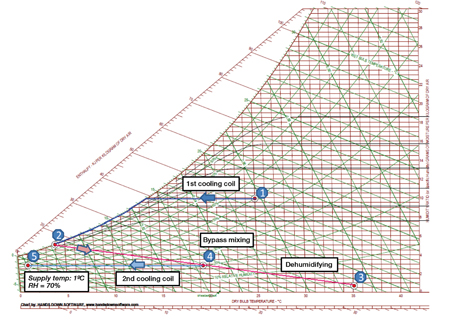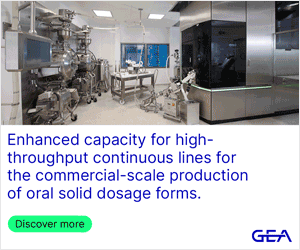Traditional methods of vaccine production involve the use of fertilised embryonic eggs, chilled to a precise temperature to enable vaccine harvesting. Tarsicio Serena, Telstar, considers the design principles behind blast chillers for egg-based vaccine production.
During the process of viral isolation from ‘embryonated’ eggs and after the incubation time, the virus-inoculated eggs with viable embryos are chilled to <4ºC. This will both kill the embryos and reduce the vessels’ bleeding and prevent blood contamination during the allantoic fluid’s harvesting, which might otherwise interfere with the final test results.
To optimise the process of vaccine production, it is critical to use blast chillers that allow a high throughput (both high egg capacity and fast chilling), that satisfy temperature, humidity and pressure demands within the chamber, and that comply with the bio-safety restrictions.
Telstar develops custom-made blast chillers that meet all these conditions and are designed to the different requirements and nature of each customer’s particular task. An outline of the design considerations that this kind of turnkey solution requires is given below.
For example, to comply with each user’s requirements, the following design criteria are considered in advance of the blast chiller design.
Room dimensions: These are defined by: the number of eggs to be cooled inside the chamber (custom-made blast chillers can be configured for any capacity, including up to hundreds of thousands of eggs); the size and load capacity of the egg trolleys; and the available space for construction of the room.
Temperature and humidity set points: The airflow must be supplied into the room at 1ºC/ 70%rH to cool the eggs. As a consequence, the room conditions should be: Room temperature (T): 1ºC ≤ T≤ 4ºC; Relative humidity (rH): <70%
Heat loads: These could be caused by: fan motors; total egg mass; lighting; heat transmission through walls, ceiling and floor; and fresh air intake. This ventilation air is needed to compensate for the air leakage through the blast chiller’s doors and also to provide the required ventilation rate for eggs’ perspiration.
Temperature uniformity: The air temperature must be very uniform throughout the whole room, eliminating thermal stratification; this is not easy to achieve since the trolleys, the trays and the eggs themselves impede the airflow. The temperature must be constant even when transient heat loads occur from door openings.
An adequate air distribution system to achieve the temperature uniformity throughout the room is obtained by installing supply and return tee-grid plenum walls at opposite sides of the room. The respective HEPA filters are placed just in front of each other to get the best airflow pattern possible, not leaving unventilated areas between the eggs.
Maximum cooling time: The maximum time that is acceptable to reach the room temperature; this is usually less than two hours.
Humidity control: At low temperature this is obtained by using desiccant dehumidifiers. These remove moisture from air as a vapour, rather than by cooling and condensating. A cooling coil to dehumidify is not suitable for close tolerance humidity control at low temperatures, because the air is so cold that the condensate freezes. The frozen condensate would block the airflow through the coil. Interrupting the airflow would create large fluctuations in room temperature and relative humidity.
Biological restrictions: For bio-safety levels the following criteria should be considered:
- 1. The differential pressure in the blast chiller room must be negative to protect everyone outside from the biological risks existent inside the chamber. An independent air-handling system allows the room pressure to be maintained reliably, thus preventing cross-contamination between production areas.
- 2. Disinfection is achieved using hydrogen peroxide vapour (HPV). Therefore all materials must be resistant to HPV (stainless steel internal wall finish, coated cooling coils, stainless steel ductwork, etc.).
- 3. 100% exhaust or recirculation design. A recirculation system can be designed if the blast chiller’s adjacent areas or rooms are also bio-contaminated. In this case, ventilation or fresh air intake just compensates for the room air leakage avoiding excessive cooling costs.
Whatever the situation, a means of general exhaust is required after the disinfection cycle. HEPA-filtered return/exhaust air is required to decrease the risk of cross-contamination.
Noise level: Although no personnel will stay inside the chamber under normal operation, the air handling system should be designed with components sized to limit noise to prevent disturbance in adjacent rooms.
Available space for mechanical equipment: The Air Handling Unit (AHU) should preferably be located just above the room, making a more compact system, and therefore minimising the risk of cross contamination (in case of having bio-safety restrictions) and decreasing significantly the ductwork costs. Moreover, the AHU’s technical area should be surrounded by a catwalk with access for the maintenance of the equipment. On the other hand, due to space restrictions, the chiller and the desiccant should be remote-mounted.
Room shell construction: The chamber structure should be designed to the following specifications:
- 1. 4 inch-thick, polyurethane insulated panels for walls, ceiling and floor.
- 2. Insulated floor with a stainless steel cover to enhance the rigidity of the surface, a non-slip treatment, and without electrostatic charge accumulation.
- 3. Floor with no internal ramp to allow transportation of the trolleys. Accordingly, the insulated panel should be embedded in the floor slab.
- 4. The chamber should be easy to clean internally (decontaminate).
- 5. Sanitary covings along the floor/wall/ceiling joints to provide cleanroom finishes.
- 6. Vapour-tight construction to reduce moisture sources. The joints will be fully sealed with silicone to prevent air and moisture infiltration along cracks.
- 7. Thermal bridge free.
- 8. Cold room insulated doors.
- 9. Tear-drop cleanroom lights.
- 10. 2 inch-thick, non-insulated panels for technical area enclosure with a standard aluminum door for maintenance access.
Due to space limitations and user’s specific requirements, the design requires non standard-sized rooms. Therefore, the insulated custom-cut panels must be made to fit each installation exactly.
Reliable, trouble-free operation: The refrigeration system should have safety features such as automatic chiller restarts.
Optional features: The blast chiller room could also include optional features, such as explosion-proof construction, power (interlocked) doors, card key access or connections to the central monitoring system or SCADA (supervisory control and data acquisition), enabling the active alarms handling to take action to mitigate an out-of-spec condition.
Applicable rules and standards: The designed system must meet minimum GMP and FDA validation requirements.
Figure 1 shows a general overview of a blast chiller design. Figure 2 shows the schematic diagram of the blast chiller operation, considering both a recirculation design and biological restrictions (bio-safety level 3).
As indicated in Figure 2, the Air Handling Unit (AHU) has the following sections:
- i) First cooling coil with cooling water at 0.1ºC (supply)/6ºC (return).
- ii) Drop collector.
- iii) By-pass section, that should be sized to drive the required process airflow to the dehumidifier, where the excess of moisture is removed, allowing it to reach the humidity level inside the chamber.
- iv) Supply fan with frequency converter.
- v) Filter F9.
- vi) Second cooling coil, with glycol-water at –6ºC (supply)/–1ºC (return). A defrosting coil should be also considered.
- vii) Drop collector (additional safety section just in case condensation in second cooling coil occurs).
The closed-control loops to be implemented in the blast chiller control system are:
1. Temperature control A time-proportioning PID controller modulates the final cooling based on actual versus set-point conditions. This provides exceptionally tight temperature control, as long as the equipment has enough cooling capacity and the air is properly distributed throughout the room.
The control system considers the inputs coming from temperature sensors installed in the supply/return ducts.
2. Pressure control An automatic control of the room pressure is carried out by combining the use of the exhaust fan 2 together with the installation of an electrical variable air volume (VAV) controller in the return air duct.
If biological restrictions are required, cross-contamination is avoided as long as the pressure inside the technical area is lower than the pressure outside. This is achieved thanks to the exhaust fan 1.
3. Humidity control The control system commands the dehumidifier function according to the values the humidity sensors acquire.
4. Airflow control A frequency converter adjusts the adequate working point of the supply fan, according to the PT sensor measure. At least a 15% increase of the nominal fan speed is assured to compensate for the increasing pressure drop caused by the progressive clogging of the filters.
The different processes that take place are represented in a psychrometric chart in Figure 3. From Point 1 (Start point at worst conditions) to Point 2, the return air passes through the first cooling coil to be cooled down and dehumidified. From Point 2 to Point 3, the 50% by-passed air passes through the desiccant wheel and consequently this air is dehumidified (and heated up). Point 4 is the mixing point of the air at point 2 conditions and the by-passed air at point 3 conditions. This air already has the required absolute humidity. From Point 4 to Point 5, the air passes through the second cooling coil to be cooled down to the desired supply conditions.
The company can also develop applications where high-performance chilling capacity with a unique custom design is required. In addition it can supply an all-in-one piece of equipment incorporating not only the refrigeration but also the secondary incubation process.
The blast chiller room can be converted into an incubation room at minimal additional cost, by simply adapting the existing control system and including the following new sections in the AHU: Heating coil (or electrical resistance) for temperature control (37±1ºC); cooling coil (with water from 18–24ºC) to keep the temperature in the range described above; and a steam injector for relative humidity control (70±10%). In the secondary incubation process, the turning-egg system is not needed. Therefore it does not require any modification in the trolley design.

Figure 3: Psychrometric chart showing the cooling processes that take place in the blast chiller (Barometric pressure: 101,325kPa)
In conclusion, while standardised blast chillers are not commercially available, Telstar’s custom-made blast chillers incorporate many features that offer both economical and operational benefits. Moreover, the versatility of the design allows possible future adaption to other functions, even combining refrigeration and incubation in the same system.
The author would like to acknowledge the help of Miguel González, draft designer, Telstar, in compiling this article.




